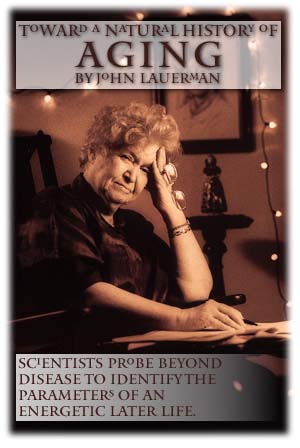Main Menu · Search ·Current Issue ·Contact ·Archives ·Centennial ·Letters to the Editor ·FAQs

It's the same each time we meet. I'm conversing with Henrietta Aladjem
at her condominium just outside Boston. Trading ideas across her dining-room
table is an elaborate game of confidences, intimidation, braggadocio, hopes,
some gloating, and laughter. We start by deploring the assassination of
a foreign leader, move to the violence of the inner cities, briefly touch
on the nature of learning, and then return, as we so often do, to a discussion
of the power of human strength, of the unfathomable reasons why one person
flourishes while another flounders.
It's a familiar resting point for us, and as we revisit oft-repeated views,
I discern signs of another familiar pattern. Once again, the "elderly"
woman I'm talking with has worn me out. Not with shouting, pestering, or
shrill demands for attention, but with energy. With persistence, idea-making,
and curiosity.
Chances are that you already know of Henrietta, or have even made her acquaintance.
The former Widener librarian is one of those ubiquitous personalities who
turn up in Hollywood, at the Massachusetts State House, at Congressional
offices, at the National Institutes of Health, even the White House.
The revered Canadian physician Sir William Osler once said that if you want
to live a long life, get a chronic disease and take good care of it. For
better or worse, Henrietta has followed this advice for more than 30 years,
since her diagnosis with an autoimmune disease, systemic lupus erythematosus.
Her energy seems inexhaustible. She's written five books about lupus. Two
weeks ago, she was the featured speaker at the annual meeting of Lupus Canada.
This morning, she drove herself to Framingham and bought a couch.
Now she sighs and rests heavily in the dining-room chair where she writes
each day, surrounded by old-world furnishings that have accompanied her
throughout a lifetime-a mirror-backed china cabinet in which her stationery
resides, a couple of dark wood sideboards topped with ornamental plates.
She is working on her sixth book. It won't be her last. There's frequent
talk of a screenplay, or sometimes a romance novel. Those who have tried
to push her toward retirement have underestimated her. For 14 years, Henrietta
was editor of Lupus News, published by the Lupus Foundation of America,
which she established. In March, she sent out the first copies of Lupus
Letter, a new publication for patients with the disease. Henrietta's
in her eighth decade of life, and it's utter, hectic chaos.
"I know I am old, but I have taken care of my skin," she says
in a strong Bulgarian émigré's accent, only slightly slurred
by the Bell's palsy that affects one side of her face. "I do not have
the skin of a 79-year-old woman. And you know, inside I am bounding with
enthusiasm. There are many, many things that I am deeply interested in,
and I have the enthusiasm of a 30-year-oldof a child."
![]()
In his later years, Bertrand Russell said that he never felt like an old
man, but rather like a young man who had something not quite right with
him. What is age? A synonym of infirmity and frailty? A number? A pattern?
A risk factor? When we say that someone is aging, what exactly does that
imply? When someone says, "I feel old," we assume the person is
fatigued and dispirited. But there are plenty of people whose experience
of aging belies that image, people who continue to thrive, without or in
spite of illness and disability.
Take the number 65. It's a number commonly associated with slowing down,
retirement, a desire for warmer climes and fewer responsibilities...and
increased susceptibility to disease. For many Americans, these associations
are well founded. The elderly do consume more health services than any other
age group. They visit more doctors, take more drugs, spend more days in
hospitals and nursing homes, and in general need more care than other people.
But that doesn't accurately reflect the real diversity of the elderly in
terms of health and mental status. As the over-65 population blossoms, hidden
vitality and energies among these people will surface. Like "old Father
William," stereotypes of the helpless, frail elderly are about to be
stood on their heads. The Baby Boom countdown to 65 is at 13 years, and
as it gets closer, expect the unexpected, because what is about to happen
has never happened before on this earth.
As much as any fresh wave of immigrants, the elderly are about to become
a much more visible component of our national scene. Daily, 3,000 people
turn 65, and only 2,000 above that age die, leaving 1,000 new members of
the elderly population. In the 30 years between 1990 and 2020, the over-65
American population will grow by 71 percent, more than twice the rate of
growth in the general population. By the year 2020, one out of six Americans
will be over 65. The term "retirement community" will describe
just about any neighborhood in the United States.
 Public health measures introduced in this century-advances in nutrition,
hygiene, and vaccination-have redefined old age. One hundred years ago,
it wasn't unusual to become a sage grandparent before your fortieth birthday,
or to die soon afterward. In 1900, average life expectancy for American
women was 49, for men 46. Since then, we've seen average length of life
climb by about 50 percent, to 78.8 for girls and 72.1 for boys. This means
that half the people now alive in this country will live past 75.
Public health measures introduced in this century-advances in nutrition,
hygiene, and vaccination-have redefined old age. One hundred years ago,
it wasn't unusual to become a sage grandparent before your fortieth birthday,
or to die soon afterward. In 1900, average life expectancy for American
women was 49, for men 46. Since then, we've seen average length of life
climb by about 50 percent, to 78.8 for girls and 72.1 for boys. This means
that half the people now alive in this country will live past 75.
Needless to say, change like this doesn't occur very often; the previous
25-year increase in life expectancy took approximately the length of recorded
history, or about 4,000 years. By the year 2050, average American life expectancy
will climb further, to a projected 82.6 years.
"Aging is a new field driven by demographics as much as by scientific
discovery," observes Ken Minaker, M.D., chief of a new geriatric medicine
unit at Massachusetts General Hospital and associate professor at Harvard
Medical School. "Today's elderly are pioneers of a new kind of aging.
The next century will be dominated by the concerns of the elderly."
